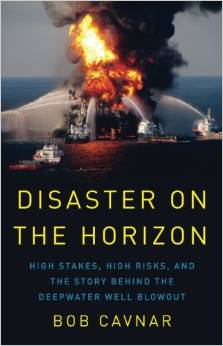Disaster on the Horizon: High Stakes, High Risks, and the Story Behind the Deepwater Well Blowout
Review of Bob Cavnar's book by Christine H Kroll

Almost four years since the disaster on the Deepwater Horizon floating oil drilling unit, at a time when the government is lifting its ban for new oil leases to BP (British Petroleum) in the Gulf of Mexico, it’s important to review what has happened, particularly in light of current events.
When the oil rig the Deepwater Horizon suffered a massive well blowout on April 20, 2010, the public was blissfully unaware of the awful significance for years to come. In fact, a media blackout was imposed, supposedly to calm the public.
In Disaster on the Horizon: High Stakes, High Risks, and the Story Behind the Deepwater Well Blowout, author Bob Cavnar, an oil industry expert, offers a breathtaking account with real life perspective on the catastrophe which resulted in an estimated 4.9 million barrels of oil polluting the Gulf of Mexico over the next four months.
All evidence indicates that the blowout preventer was not working properly, safety systems had been turned off, and due to difficulties in drilling the Macondo well down to 18,000 feet, the BP engineers “decided to run one long string of casing from the bottom of the well all the way to the wellhead” thereby jeopardizing the strength and integrity of the casing under drilling mud and well pressures.
Over 4000 oil and natural gas platforms located in the Gulf of Mexico (ERMA Map & Data from NOAA and University of New Hampshire Coastal Response Research Center)
BP’s engineers took shortcuts in order to ensure that they would expedite the opening of the $100 million well and recoup the $34 million they paid to the Minerals Management Service on its lease. Shortcuts were permitted by the Mineral Management Service (MMS), whose prime responsibility under Bush Administration Executive Order 13212 was “to expedite their review of energy related projects” with a maximum 30-day time limit.
In the Aftermath (Chapter 12), with the conflict of interests laid bare, Department of Interior Secretary Ken Salazar determined to break the MMS up into three agencies: Office of Natural Resources Revenue (to collect revenue), Bureau of Ocean Energy Management (BOEM)(environmental studies and leasing), and Bureau of Safety and Environmental Enforcement (BSEE)(permits and field operations).
This would seem to have had some effect on at least curbing the appearance of those boilerplate reviews, the influence money-driven politics, and revolving door private-public partnerships. However what is really needed is a complete energy overhaul because according to at least one analyst, U.S. war strategy now includes Russia.
Here Cavnar’s book, published in late 2010, (and his lecture circuit) is far less harum-scarum accounts than devoted to some true consciousness-raising, particularly with regard to safety and responsibility owed by the oil industry for the sake of the Law of the Commons–the oceans, wildlife, and fossil fuel supply.
Recent research online by the Examiner reveals the later enactment of the new Drilling Safety Rule, which ensures sectional risers, casing, cementing, installation, monitoring and testing of well bores and blowout preventers are both more properly planned and designed.
But as early as January 2012, President Obama’s “all of the above” energy policy assured that Gulf of Mexico oil leases were once again up for sale. According to the notice, the BOEM estimates that the Central Gulf of Mexico contains “close to 31 billion barrels of oil and 134 trillion cubic feet of natural gas that are currently undiscovered and technically recoverable.”
The numbers recoverable sounds huge until one realizes that the United States alone consumes about 20 million barrels a day. Doing the math, 31 billion barrels might only last 1550 days (aproximately 4.24 years).
If the world can’t curb its appetite for oil, then big oil companies must extract every square inch of oil bearing strata in the Gulf of Mexico as soon as possible.
Especially with the U.S. “all of the above” energy policy which sanctions increased oil and gas production, consumers will continue to mimic the tastes of politicians who enjoy being driven in luxurious albeit superannuated motorcades.
My rating for this never-too-late-for-change compelling book is 5-stars.


